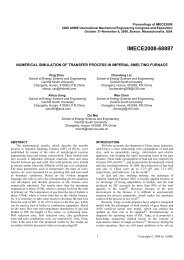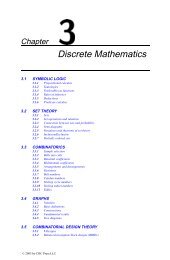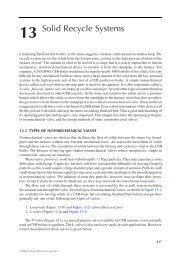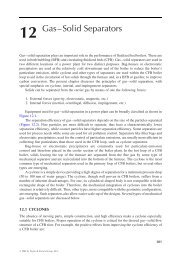Chapter 4: Geometry
Chapter 4: Geometry
Chapter 4: Geometry
Create successful ePaper yourself
Turn your PDF publications into a flip-book with our unique Google optimized e-Paper software.
4.7.7 CLASSICAL CONSTRUCTIONS<br />
The ancient Greeks used straightedges and compasses to nd the solutions to numerical<br />
problems. For example, they found square roots by constructing the geometric<br />
mean of two segments. Three famous problems that have been proved intractable by<br />
this method are:<br />
1. The trisection of an arbitrary angle.<br />
2. The squaring of the circle (the construction of a square whose area is equal to<br />
that of a given circle).<br />
3. The doubling of the cube (the construction of a cube with double the volume<br />
of a given cube).<br />
A regular polygon inscribed in the unit circle can be constructed by straightedge<br />
and compass alone if, and only if, Ò has the form Ò ¾ Ô ½ Ô ¾ Ô , where is a<br />
nonnegative integer and the Ô are zero or more distinct Fermat primes (primes of<br />
the form ¾ ¾Ñ ·½). The only known Fermat primes are for 3, 5, 17, 257, and 65537,<br />
corresponding to Ñ ¼ ½ ¾ ¿ . Thus, regular polygons can be constructed for<br />
Ò ¿,4,5,6,8,10,12,15,16,17,20,24,...,257,....<br />
4.8 COORDINATE SYSTEMS IN SPACE<br />
4.8.0.1 Conventions<br />
When we talk about “the point with coordinates ´Ü Ý Þµ” or “the surface with equation<br />
´Ü Ý Þµ”, we always mean Cartesian coordinates. If a formula involves another<br />
type of coordinates, this fact will be stated explicitly. Note that Section 4.1.2<br />
has information on substitutions and transformations relevant to the three-dimensional<br />
case.<br />
4.8.1 CARTESIAN COORDINATES IN SPACE<br />
In Cartesian coordinates (or rectangular coordinates), a point È is referred to by<br />
three real numbers, indicating the positions of the perpendicular projections from the<br />
point to three x ed, perpendicular, graduated lines, called the axes. If the coordinates<br />
are denoted Ü Ý Þ, in that order, the axes are called the Ü-axis, etc., and we write<br />
È ´Ü Ý Þµ. Often the Ü-axis is imagined to be horizontal and pointing roughly<br />
toward the viewer (out of the page), the Ý-axis also horizontal and pointing more<br />
or less to the right, and the Þ-axis vertical, pointing up. The system is called righthanded<br />
if it can be rotated so the three axes are in this position. Figure 4.30 shows a<br />
right-handed system. The point Ü ¼, Ý ¼, Þ ¼is the origin, where the three<br />
axes intersect.<br />
© 2003 by CRC Press LLC










